feature
Growing Understanding From a SPARK
Connected Science Learning May-June 2022 (Volume 4, Issue 3)
By Deborah Hanuscin, Abby Whatley, Bridget Dahlman-Oeth, Paola Sanchez, Benjamin Dixon, and Daniel Savage
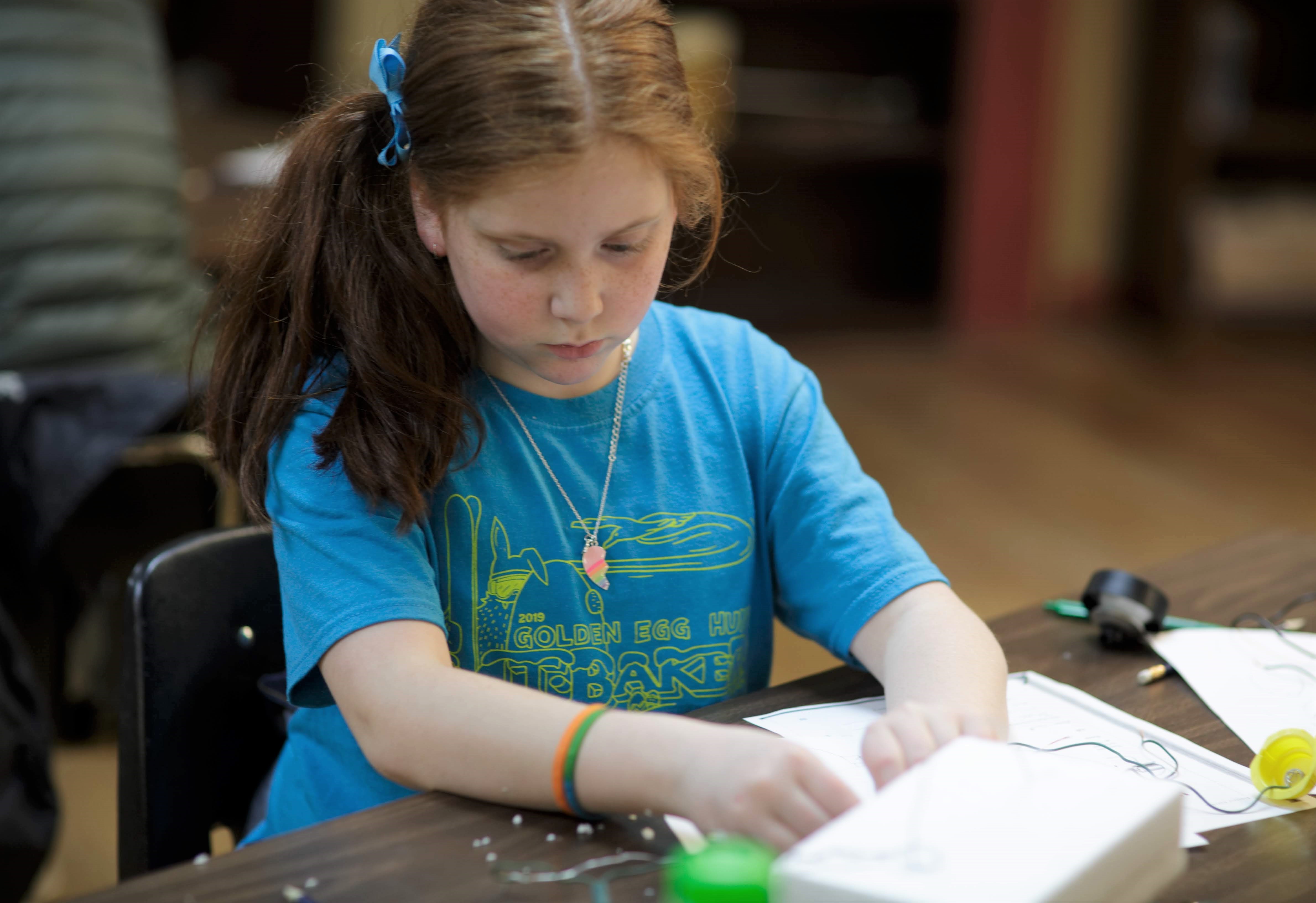
Since their release in 2013, many states have adopted the Next Generation Science Standards (NGSS Lead States) or have revised their own standards in ways that reflect the NGSS. These standards require a significant shift in the way science is currently taught in most classrooms, as well as how we prepare new teachers (Bybee 2014). Notable among these shifts are the integration of science and engineering; the focus on deeper understanding as well as application of science content; the emphasis on coherence in developing concepts; and the intent for classroom activities to reflect the interconnected nature of science and how science is practiced in the real world (NGSS Appendix A). Research shows that by collaborating in the planning, enactment, and reflection on NGSS-aligned lessons, preservice teachers can build their practical knowledge of the NGSS (Hanuscin et al. 2016). However, there are limits to what can be accomplished within the fairly brief experience of the science methods courses preservice teachers take. At the same time, school districts must balance the tensions between the reality of limited resources (e.g., time and money) and the ideal conditions necessary to shift classroom practices to align with the vision of the NGSS (Shelton 2021). Therefore, teacher education programs may also find it challenging to provide high-quality practicum experiences in science that model NGSS-aligned instruction (Hanuscin et al. 2016).
Science museums provide rich opportunities for learners of all ages to engage with science. And, while there is overwhelming evidence that informal institutions can positively impact children’s science learning (NRC 2009), there is also evidence of the role and potential for museums to support the learning of both preservice and inservice teachers (Smetana et al. 2017). We recognize that informal science institutions like museums can play an important role in supporting schools and teachers in addressing the NGSS (Short 2014; Schmidt et al. 2014) but may need to develop their capacity to do so (Jablonski 2017; Anderson et al. 2006). Museums may also encounter difficulties in shifting the focus from field trips being viewed as stand-alone events to learning experiences that are part of a broader learning ecosystem for science (Anderson et al. 2006).
Our goal in this project was to develop a partnership that connected science learning in museums, elementary classrooms, and teacher preparation programs that would enhance the capacity of all partners to teach in ways that align with the NGSS. Specifically, we created a practicum partnership through which we developed and piloted complementary classroom curriculum modules and museum-based learning experiences. Our efforts are a response to calls to support teachers in bridging the various domains in which students experience science and to model how preservice teachers could create and sustain connected learning opportunities for future students (Smetana et al. 2017).
Partners and Motivation
The primary partners in the program include the SPARK Museum of Electrical Invention, Bellingham Public Schools (BPS), and Western Washington University’s Science, Math, and Technology Education (SMATE) program—all of which are located in Bellingham, Washington. We describe each partner and their motivations for forming the partnership below.
The SPARK museum houses a world-class collection of artifacts representing the historic development of electricity, radio, and early technology from the 1600s through the present day. Visitors can observe and interact with artifacts from the laboratories of the early pioneers of electricity, from magnets and Leyden jars to Edison lightbulbs, vacuum tubes, telegraph and telephones—as well as witness a nine-foot-tall Tesla coil in the museum’s MegaZapper show. SPARK has a longstanding relationship with area schools, including BPS, through their field trip programs, and the museum regularly receives teacher requests for additional curriculum resources to support their instruction. With a full-time staff of only two, however, the museum has limited capacity to meet these needs. To provide high-quality curriculum resources, SPARK staff identified their own need to better understand the NGSS and to align their field trip program to the needs and interests of teachers.
BPS serves approximately 12,000 students (66% White). While the district recently adopted a new science curriculum at the middle school level, the current elementary curriculum materials predate the state’s adoption of the NGSS. Only 50.1% of students in BPS met the science standards for the 2018–2019 school year. The district has a longstanding relationship with WWU through the placement of prospective teachers in BPS classrooms for their practicum and student teaching experiences, and the district previously partnered with WWU’s Spanel Planetarium in 2016 to customize their programs for fourth- and fifth-grade students to strengthen the alignment with the NGSS. However, the director of teaching, learning, and technology integration for the district recognized the need to do more to support teachers and students in meeting the NGSS at the elementary level.
The SMATE program at Western Washington University offers science content, science methods, and practicum courses for future K12 teachers. SMATE recognizes the particular challenges to meeting the needs of prospective elementary teachers, the majority of whom do not major in science (Banilower 2019), and who will need to develop the capacity for continued science learning as teachers. SMATE faculty (who have tenure in the sciences or education) have engaged in professional learning related to the NGSS and worked to revise its courses and programs to better reflect these new standards; one part of this process related to the practicum experience and the desire to avoid preservice teachers using outdated curriculum materials that did not align with the NGSS.
Program Development
The partnership was initiated when the education director of the SPARK museum (Abby) reached out to a WWU faculty member (Debi) to gain expertise related to the NGSS, and invited her to give a talk to local informal educators on the topic. At the same time, BPS had reached out to WWU faculty regarding their desire to focus on providing support for integrating STEM in the elementary grades. Because of the existing field trip partnership between SPARK and BPS, it made sense for all three partners to come together. Program development began with conversations among partners about their needs and potential approaches. By coming together, we were able to leverage resources and expertise of all partners to address our individual challenges and meet our collective needs (See Table 1).
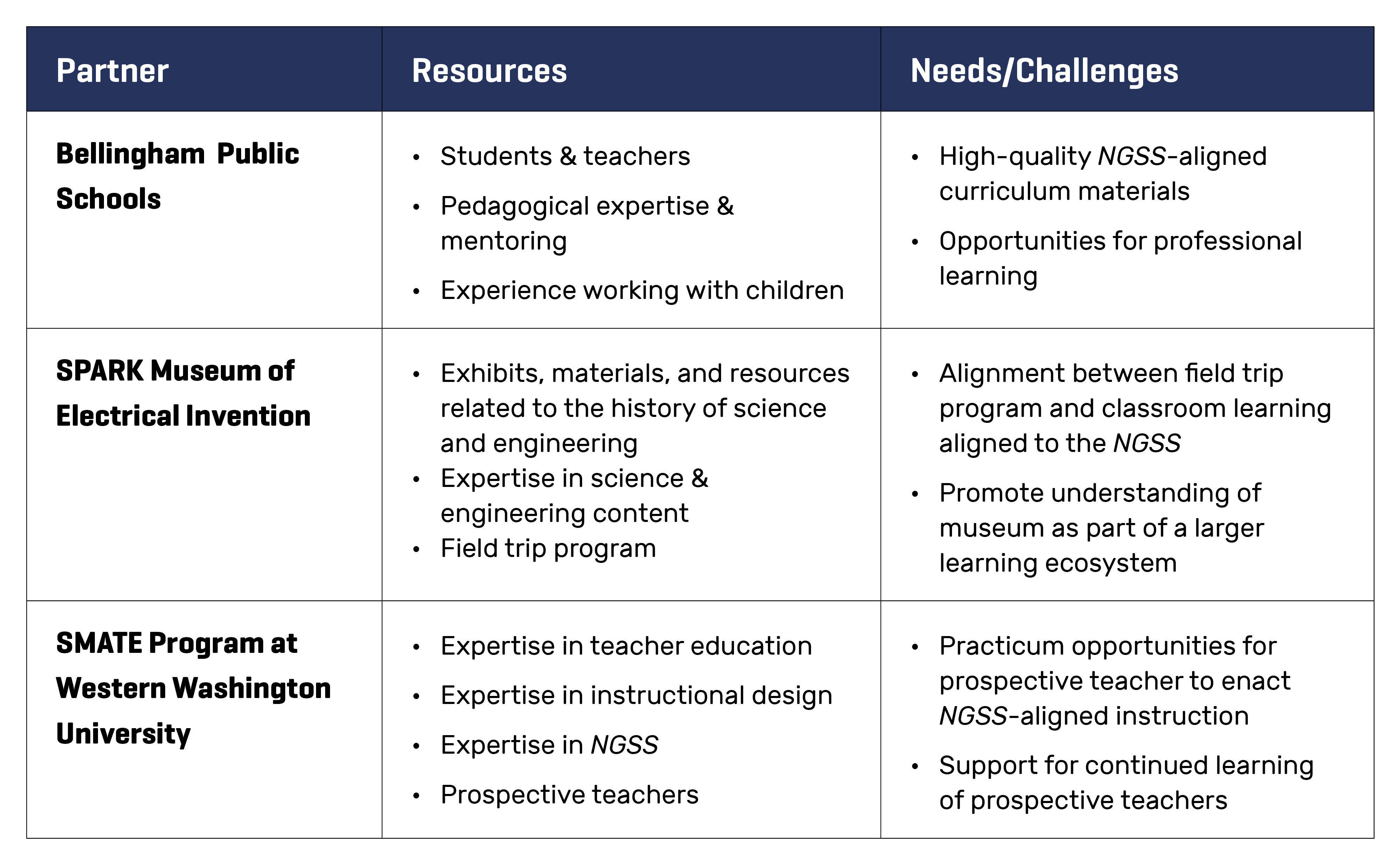
The program we developed was a practicum-based partnership through which preservice teachers—working collaboratively with the support of their professor, SPARK museum staff, and BPS personnel—would develop a set of curriculum modules aligned with the NGSS and complementary to the SPARK field trip program. BPS teachers participating in the SPARK field trip program would host WWU students for their practicum, during which they would collaborate to implement and evaluate the curriculum modules. Finally, with input from all parties, the preservice teachers would revise the curriculum modules and make them available at no cost to teachers through the SPARK museum’s educational resources.
The Curriculum Modules
Development of the curriculum modules (Figure 1) took place over one academic quarter (the elementary science methods course) with implementation and revision occurring in the subsequent quarter (the elementary science practicum). We leveraged existing high-quality curriculum materials, such as those curated resources in the National Science Teaching Association’s NGSS Hub, and adapted successful NGSS-aligned approaches used by others (e.g., the development of “client cards” for introducing engineering tasks described by Capobianco and colleagues, 2013). We also used the BSCS 5E Learning Cycle (Bybee 1997) as a framework for instructional design and conceptual storylines (Hanuscin et al. 2016) as a way to support coherence within and across lessons.
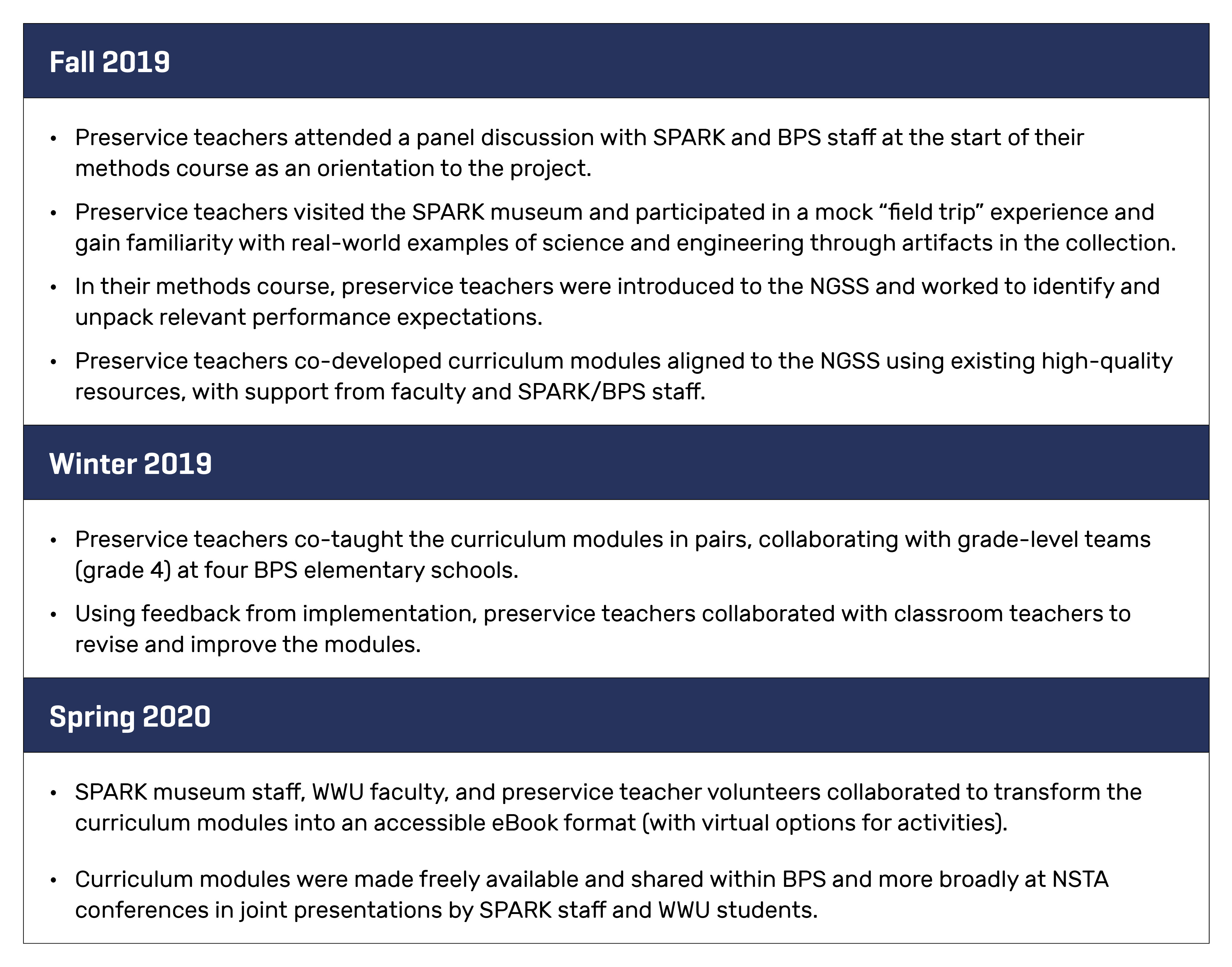
The completed curriculum modules (see Figure 2) address five NGSS performance expectations spanning engineering and physical science (Figure 3). All modules include supporting materials about the pedagogical framework (5E), as well as a conceptual storyline for each module (Hanuscin et al. 2016), materials needed, handouts, information about the NGSS alignment, and more so that educators can understand how to implement and/or adapt the materials for use with their students in productive ways. Lesson activities use artifacts from the SPARK collection and complement the field trip to the SPARK museum, which can serve as either a provocation or culminating event. When students visit the museum, they are presented with real-world examples of the work of scientists and engineers with a focus on the historical evolution of ideas and electrical devices, showcasing the development and optimization of devices over time. In this way, the field trip provides context for students’ work in the classrooms and helps them make connections between what they are doing and what scientists and engineers do.
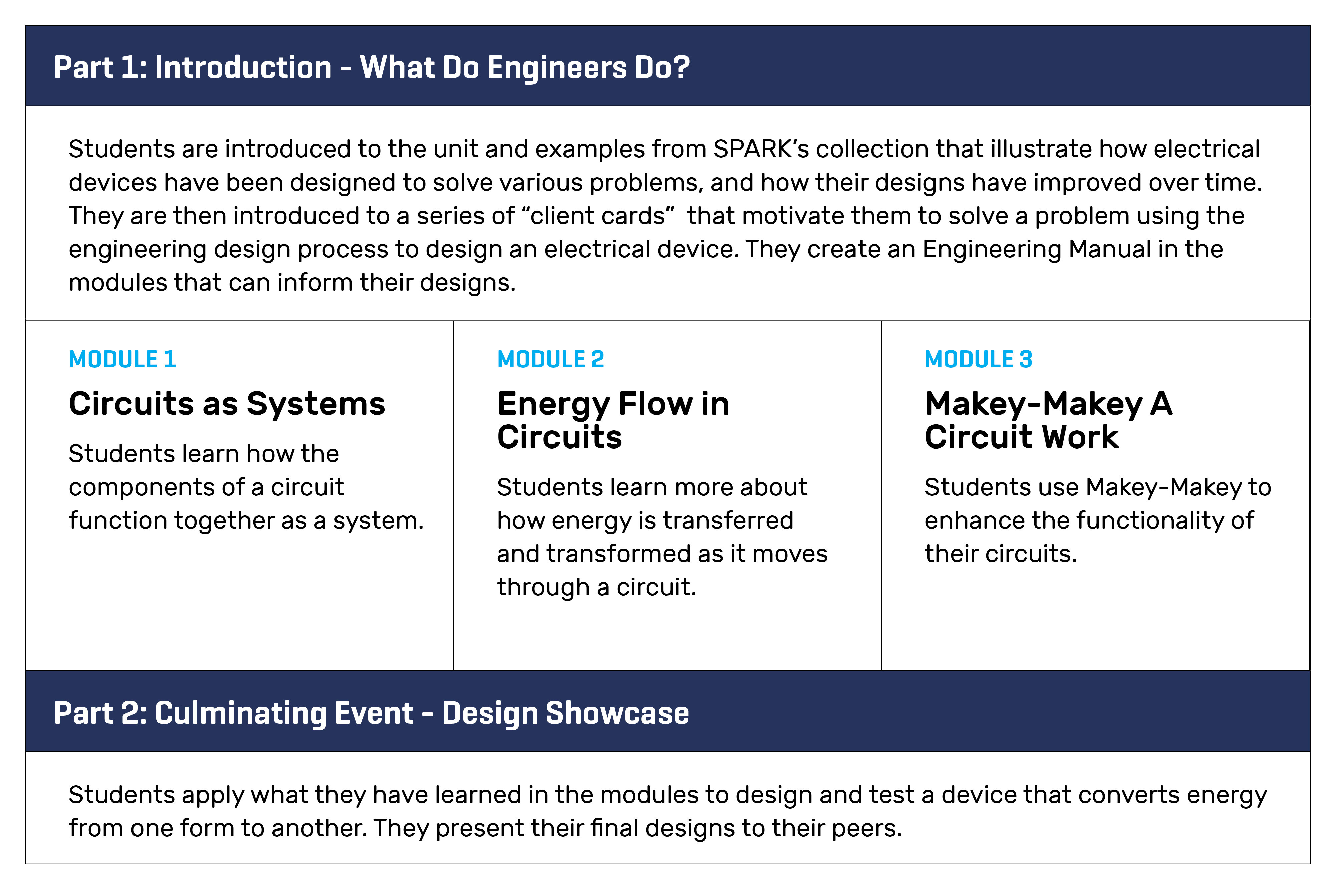
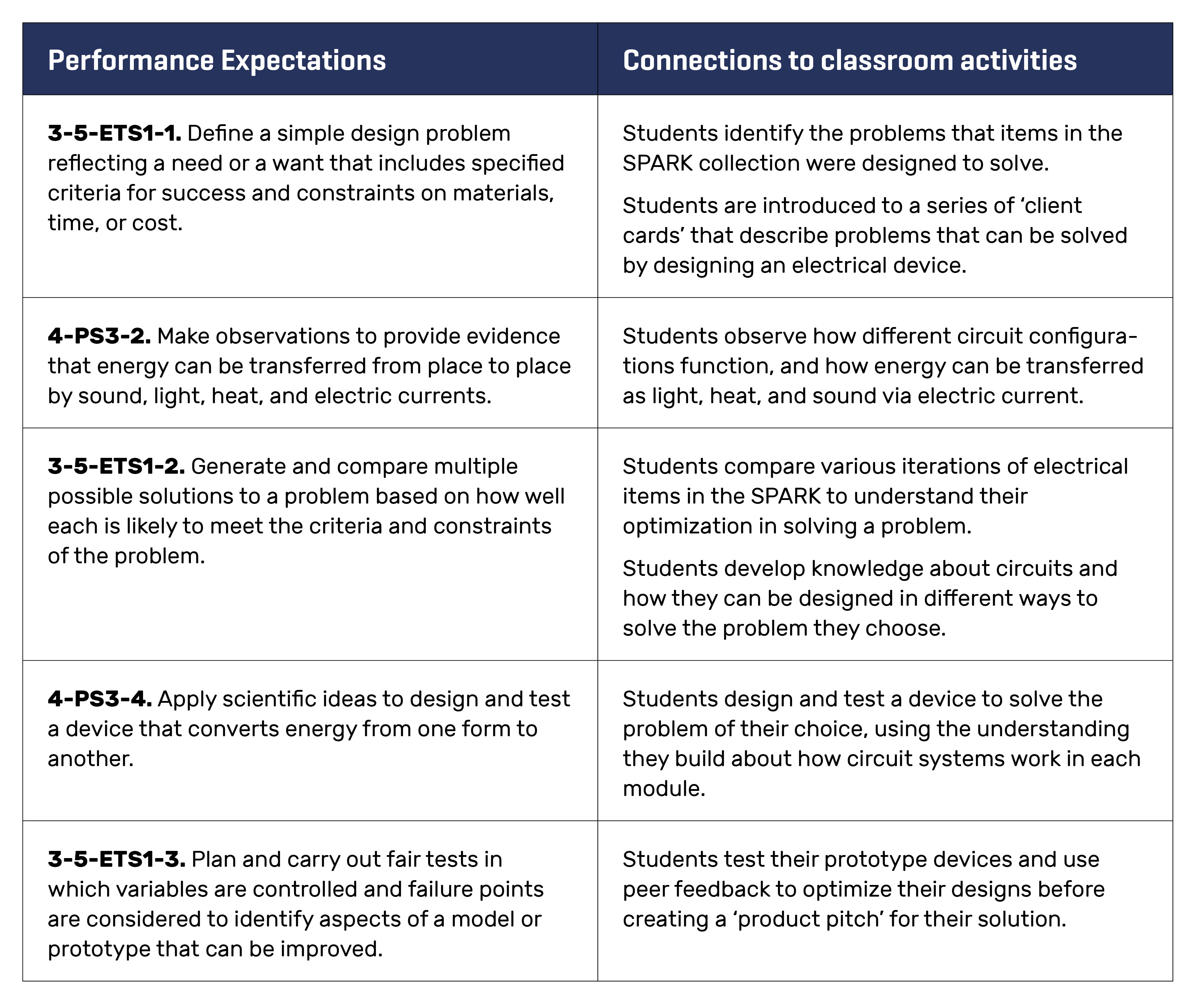
Evaluation
The creation and revision of the curriculum modules helped achieve our goal of developing the capacity of all partners to make many of the conceptual shifts identified in Appendix A of the NGSS. As an unfunded initiative, we did not have the resources of an external evaluator; however, we engaged in joint reflection on our partnership to assess its value and consider whether and how we might continue to collaborate in this way. In evaluating the success of our partnership, we sought evidence for this in preservice teachers’ reflections, the modules themselves (including both drafts and the revisions made during implementation), and feedback from students and teachers. Below we highlight four key shifts that we believe our partnership supported.
One key shift in the NGSS is the integration of science and engineering. Few, if any, elementary teachers take coursework in engineering (Banilower 2019). The SPARK museum—with its focus on historical developments in science, technology, and engineering—provided excellent examples of this integration in real life and contributed to conceptualizing how science and engineering might be integrated in the classroom. Developing the curriculum modules provided an opportunity for preservice teachers to expand their knowledge of both science and engineering, and the relationship between them. According to Danny:
My subject matter knowledge for teaching science has also expanded to include engineering, which I had little knowledge of prior to this course. Students are doing science when the goal is to answer a question. Students are doing engineering, on the other hand, when the goal is to define and solve a problem.
The integration of science and engineering also provided opportunities for focusing on deeper understanding of content as well as application of content. This shift was particularly challenging for preservice teachers, who initially conceptualized science as being more activity-focused. As Ben explained, "My initial lesson plan represented my preconception of science being more driven by hands-on activities where students just magically grasp the big concept I wanted them to learn." In the modules, the client cards presented problems that invited students to use the knowledge they developed about circuits and energy to design a solution. Several preservice teachers commented on the success of this approach and their observations of students’ ability to apply their new understandings:
The biggest indicator for me was at the very end when the students created their designs. Some even figured out how to use the switch and understood how it worked without ever having seen it. The students' designs all really impressed me because they created creative and unique circuits centered around solving a problem. The proof for me was at the end when I saw their designs and when I talked to the students individually about their designs it was clear that they were understanding and could apply what they were learning.
Despite this success, preservice and collaborating teachers felt there was a need for greater scaffolding to support all students in drawing on the knowledge they were developing about circuits. In revising the modules, we incorporated a student-generated Engineering Manual to be used at the end of each module as a way for students to keep track of key scientific ideas they had learned that could inform the design of their final solution. Specific prompts for the Engineering Manuals were designed to help make students’ thinking visible and allow teachers to evaluate students’ progress through the modules, identifying areas for individualized support.
For many preservice teachers, the ideas in the modules were new content that they were learning as they planned; however, the process of creating the modules emphasized for them the importance of content knowledge in being able to design lessons in which the science concepts build coherently, another key shift in the NGSS. One of the tools we used to build coherence within and across the modules was a conceptual storyline (Hanuscin et al. 2016, adapted from Bybee 2015). As Paola noted, “Building conceptual and coherent storylines is challenging with new content and teachers must have a strong and deep knowledge base to do this.” Building a conceptual storyline for each module helped preservice teachers consider the connections between activities and how those ideas built over time across modules. The notion of a “storyline” also helped them critically evaluate the lessons in terms of whether students were making these intended connections:
At times, the lessons did seem a little disconnected, but they did all eventually tie back together. I wasn’t entirely sure if the students were understanding the connections while we were teaching the introduction module, module 1, and module 2. But once we got to module 3, the students were using some of the vocabulary we had taught them and making connections between the Makey-Makeys and the circuit systems we had built. It was wonderful to see everything come together!
Others realized how each piece of the experience—including the field trip—was necessary to create an overall coherent learning experience for students. "Students struggled to make the connections between the concepts we were exploring and how it directly related to the client cards and field trip; however, once we finished at the SPARK museum, they all were excited to “put their engineer caps” on and find solutions to their client cards." This affirmed the importance of the learning that took place in both spaces (school and museum settings).
The activities in the modules—which collaborating teachers noted were “high quality” and more “interactive” than their existing science curriculum materials—were intended to mirror what scientists and engineers do. That is, to reflect the interconnected nature of science as it is practiced and experienced in the real world. Conversations between preservice and collaborating teachers during implementation made clear, however, that what was missing were actual examples of real scientists and engineers that might challenge stereotypical views about who can do science. In the revision process, SPARK museum staff were again an important resource. With their help, we revised the modules to highlight the work of scientists such as Lewis Latimer, a black inventor and patent draftsman whose Maxim Lamp, developed in 1881, is in SPARK’s collection. This also prompted us to strengthen the connection between real-world examples of science and engineering innovations to specific items in the collection that students would observe on the field trip. In turn, this helped museum staff understand an area in which they could fulfill an important need for teachers in terms of showcasing the diversity of those involved in the history of scientific and engineering developments related to electricity. As SPARK staff explained:
Being able to work in partnership helped us fill gaps in what we are able to do, and to carry out our mission and serve students better than we could do on our own. It not only gave us a better understanding of the NGSS, but helped us gain insight into the realities of the classroom and challenges teachers encounter implementing science. This helped us realize what kind of supporting role we can play in meeting the vision of the NGSS.
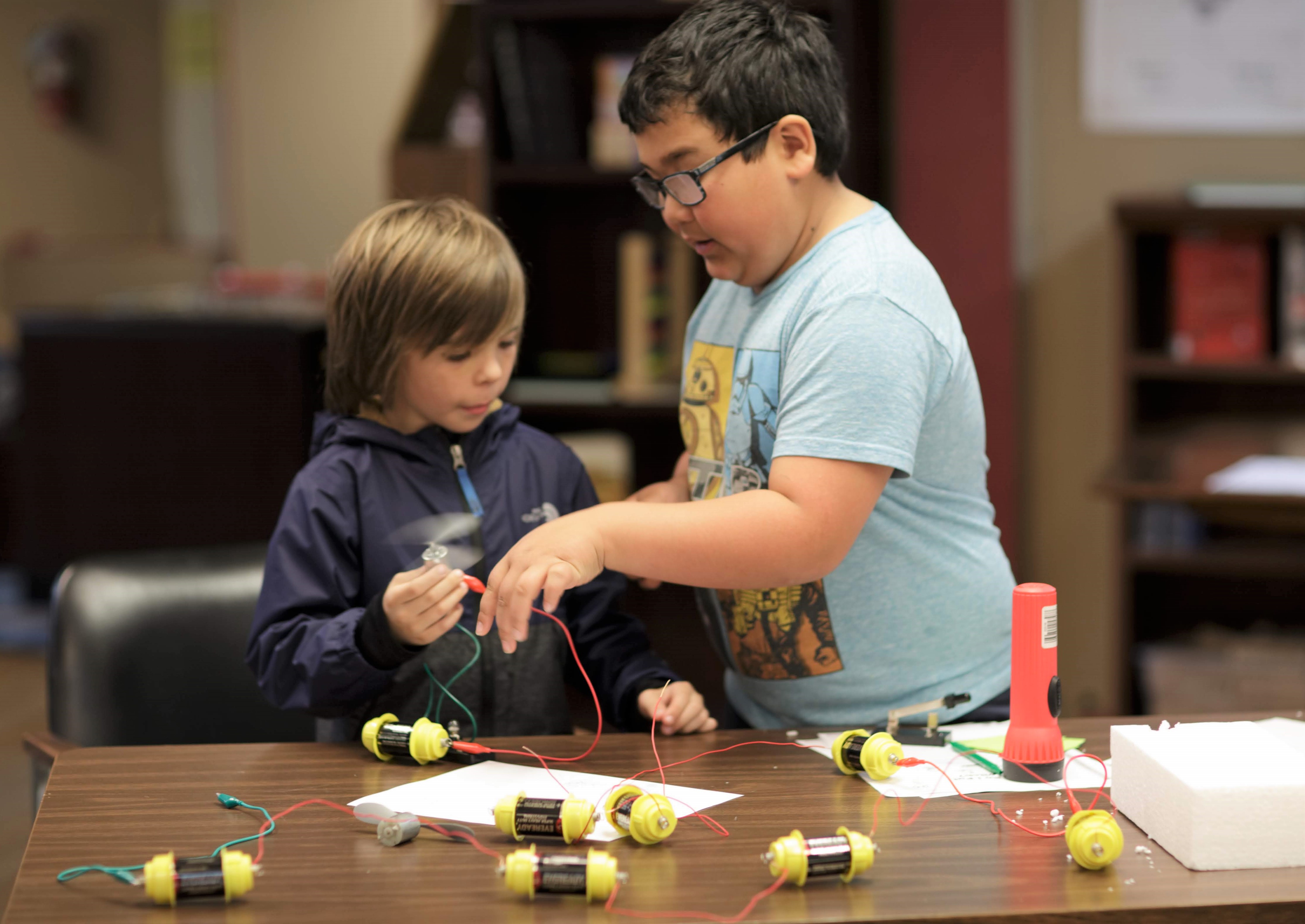
Lessons Learned and Challenges
In many ways, our partnership was a success—but not one easy to replicate without careful planning and consideration, as well as investment from all partners. In this section, we describe both lessons learned and challenges we encountered.
Lesson #1: The Benefits of Common/Shared Teaching Experiences
One notable difference between this practicum arrangement and the traditional arrangement is that rather than being spread across grade levels and topics, all preservice teachers were working on and implementing the same lessons. This benefited the instructor while providing targeted support but also created different affordances for preservice teachers to support one another. All preservice teachers were paired for the practicum experience, so they had peer support as well as support from the collaborating teachers. As one explained, “Having a partner teacher to bounce ideas off of and to offer support when things did not go so well was extremely helpful.” Working on implementing the same lessons also afforded opportunities for collaboration beyond their teaching partners. Bridget noted, “We met outside of class as colleagues to prepare and support one another.” In this manner, preservice teachers could draw on their experiences across classrooms and schools to engage in solving shared problems and challenges in implementing the modules. This also allowed the group to compare and contrast how different approaches worked, or how the same approaches might work differently with different students.
Lesson #2: The Importance of Collaborating as Colleagues
While the structure of the practicum provided a common experience, we recognize that developing trust in each other and the ability to collaborate as colleagues was necessary for realizing the affordances of that shared experience. A sense of collegiality formed in the methods course as preservice teachers worked together but also extended into the practicum as preservice teachers collaborated with classroom teachers. As Paola noted, “This was totally different from any other course or practicum experience; we built relationships as colleagues (with teachers and our peers).” Importantly, the scope and nature of this project was such that collaboration was necessary—no one teacher (preservice or inservice) could accomplish individually what the group could accomplish through collaboration. As Ben explained, “Collaborating with others in this way prepared us for collaborating in the future. It helped me realize how much each person has to offer, and how important collaboration and partnership can be as an educator. I feel more prepared now to collaborate in my future career.” Similarly, other preservice teachers noted the value of collaboration with community partners like the SPARK museum, “I feel like I have a blueprint now for how to connect with the community beyond my classroom—I feel empowered as a teacher knowing I can do that!”
Lesson #3: The Value of Authentic Engagement
Our partnership provided a meaningful context for preservice teachers to enact what they were learning in their teacher education program, engaging in an approximation of practice (Grossman et al. 2009) that was authentic to the work of teaching science, not just in terms of collaboration, as mentioned above, but also in terms of teaching practice and motivation. Preservice teachers recognized that their instructional design went “beyond the hypothetical lesson plans” they often wrote in other courses. Rather than viewing the project as an assignment, they viewed it as an authentic form of engagement. As Bridget reflected, “In terms of our motivation, we were not just doing it for the A. When we were connected to all these stakeholders, we were accountable and wanted to make it meaningful and quality.” The cycle of planning, enacting, and reflection in which they collaborated with classroom teachers provided them with new insights about teaching. Rather than think at the lesson level, preservice teachers could view the curriculum more holistically, “I was able to see how all the pieces connect (standards, activities, questioning)—and better understand underlying pieces of the curriculum and rationale.” Teaching is complex work that can often appear deceptively simple; this complexity became visible to preservice teachers through their engagement in the entire process from unpacking the NGSS to refining the curriculum modules. Though daunting, preservice teachers saw the value of this challenging work:
When it was first discussed that we would be creating [the modules] as a class, I immediately felt overwhelmed. But I decided to challenge myself and elected to [work on module 3] even though I felt I had no idea what I was doing. This is something I never would have done at the beginning of [my program] because I wanted to stay within what I was comfortable with. Which makes no sense to me because that’s not what I want my future students to do when I teach them science! I want them to branch out and feel confident enough in themselves to try something they are unsure about.
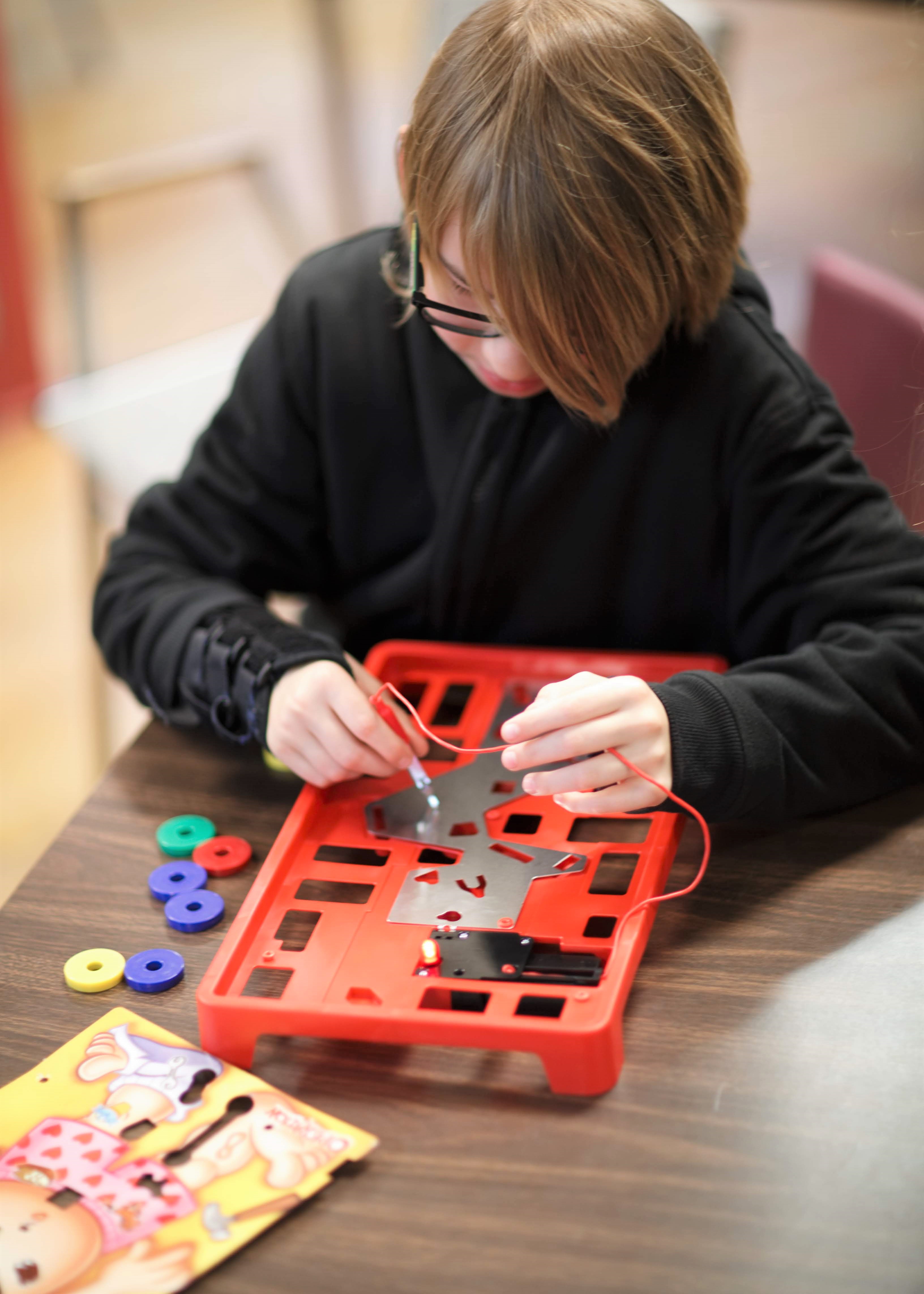
Challenge #1: Time
While we were able to make changes to the nature of the practicum experience, one thing not within our power to change was the schedule. As a “course,” the practicum experience is scheduled for Tuesdays, Thursdays, and Fridays from 12:30 p.m. to 2:30 p.m. Preservice teachers are enrolled in other courses as well, so we are limited to this schedule for their teaching in classrooms. This meant that preservice teachers could not teach lessons on consecutive days and that classroom teachers had to be flexible in adjusting their schedules for science to be taught during the afternoon time block. Additionally, because the BPS district implements an “early release schedule” on Thursdays, our window for enacting the lessons was even more limited. Within the 10-week quarter, preservice teachers were able to teach a total of 8 sessions, with the time for collaborating with teachers outside of this varying greatly from site to site. Some grade-level teams had planning time that closely aligned with our schedule, offering greater opportunities for conversation about implementation than others. Additionally, not all preservice teachers got to accompany their classrooms on the field trip, due to their other coursework. An important consideration in undertaking partnerships of this nature is the potential for (mis)alignment of schedules.
Challenge #2: Materials
Access to materials can be a barrier to implementing the kind of instruction envisioned by the NGSS. The world-class collection of artifacts at the SPARK museum enables teachers to showcase real-world examples of engineering design that they could not have provided on their own. The SMATE program’s equipment center had all necessary materials available for the modules to be implemented in classrooms and was able to supplement the materials available to BPS teachers. However, given the lessons were being simultaneously taught in 12 different classrooms, this necessitated sharing of materials and equipment within and across schools. BPS district staff and SPARK museum were helpful in ensuring that materials were available, but the process was not perfect. In cases where batteries or bulbs were not working, or few Makey-Makey kits were available, classes had to make less-than-ideal adjustments to their plans. Subsequently, Western Washington University and SPARK have worked with BPS on grant funding to provide additional materials and equipment to teachers and have instituted a check-out program for teachers through the materials and equipment resource center housed within SMATE.
Challenge #3: Flexibility
Because we implemented the modules in 12 different classrooms at 4 different schools, there was understandably a high level of variation in the needs, interests, and abilities of students, and the way in which teachers and preservice teachers decided to implement specific activities. For example, some classes voted on a single client card to address, others assigned different client cards to each group, and others allowed individual students to choose. One class even created a new client card based on students’ interests. Additionally, some classes focused more on oral and pictorial forms of communication, whereas others relied more heavily on written forms of discourse. As one preservice teacher commented, “I really liked the flexibility we had—it didn’t feel like a script to follow—but we were able to see how all the pieces connect and keep to the storyline of the unit as we made changes.” Capturing these variations and rationales was an important part of our revision process, to support teachers in making productive adaptations that were consistent with the overall storyline and intention of the modules. We recognize this is likely to be more challenging to teachers who are new to using the materials or who are less familiar with the content.
Next Steps
The modules we created were developed into an eBook format and are freely available to teachers through the SPARK website. We note that both development and implementation of the modules occurred in-person, as this program preceded the shift to online learning necessitated by the COVID-19 pandemic. In response to the pandemic, SPARK museum staff—with the support of WWU faculty and a cohort of volunteer preservice teachers from the program—were able to incorporate virtual options into the eBook for teachers to use during online instruction.
We are excited to observe the continued use of these modules by participants and are working to support others in using the materials as well. Several of the preservice teachers involved in this program were subsequently assigned to student teach in fourth-grade classrooms at other schools in BPS and have been able to collaborate with a new group of teachers in implementing the modules. Several preservice teachers who have since graduated are also using the modules in their classrooms across the state. SPARK, BPS, and WWU are currently engaged in developing professional development opportunities for teachers interested in learning more about the curriculum. SPARK staff and preservice teachers have also presented the modules at NSTA conferences, expanding the pool of users beyond our state and region. Our efforts have also drawn the attention of other informal science education institutions in our region, who will now be engaging in similar collaborations with BPS and a new cohort of preservice teachers from WWU!
Concluding Thoughts
The program we created illustrates the benefit of collaboration between formal and informal education to support teacher learning. By working together, we were able to build knowledge and capacity among all partners to make the conceptual shifts required by the NGSS, but also create something that would be useful to others in making these shifts as well. We hope that these efforts will SPARK continued learning among all partners and from CSL readers!
Deborah Hanuscin is a professor at Western Washington University – SMATE/Elementary Education in Bellingham, Washington, Abby Whatley is a director at SPARK Museum of Electrical Invention in Bellingham, Bridget Dahlman-Oeth is a student teacher at Western Washington University in Bellingham, Paola Sanchez is an elementary teacher at Everett School District in Everett, Washington, Benjamin Dixon is a student teacher at Western Washington University in Bellingham, Daniel Savage is an elementary teacher at Bellingham Public School District in Bellingham.
citation: Hanuscin, D., A. Whatley, B. Dahlman-Oeth, P. Sanchez, B. Dixon, and D. Savage. 2022. Growing Understanding from a SPARK. Connected Science Learning 4 (3). https://www.nsta.org/connected-science-learning/connected-science-learning-may-june-2022/growing-understanding-spark
Curriculum NGSS Physical Science Science and Engineering Practices Elementary Informal Education Pre-service Teachers


